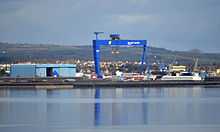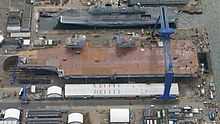Rosyth Dockyard

Rosyth Dockyard is a large naval dockyard on the Firth of Forth at Rosyth, Fife, Scotland, owned by Babcock Marine, which formerly undertook refitting of Royal Navy surface vessels and submarines. Before its privatisation in the 1990s it was formally the Royal Naval Dockyard Rosyth. Its primary role is now as integration site for the Royal Navy's newest aircraft carriers - the Queen Elizabeth-class.
History

Construction of the dockyard by civil engineers Easton, Gibb & Son commenced in 1909. At the time, the Royal Navy was strengthening its presence along the eastern seaboard of Great Britain due to a naval arms race with Germany.
First World War
In 1903 approval was given with an estimated cost of £3 million for "works" and £250,000 for machinery spread over 10 years. The site was 1,184 acres and the main basin would be 52.5 acres. Large enough for 11 battleships or 22 if doubled up. The first ship to dry dock there was the pre-dreadnought battleship HMS Zealandia on 28 March 1916. [1]
Interwar years
- HMS Magnificent (1894) as an ammunition store ship between October 1918 & 4 February 1920.
- HMS Crescent (1899) as a harbor depot ship between 1 May 1920 and 17 September 1921.
- HMS London (1899) as a minelayer between February 1918 and January 1919.
Post war

Privatisation

Babcock Thorn, a consortium operated by Babcock International and Thorn EMI, was awarded the management contract for Rosyth dockyard in 1987; with Rosyth Dockyard becoming a government owned, contractor run facility. This contract was awarded in parallel with Devonport Management Limited's contract to run Devonport Dockyard, Plymouth. In 1993 the Ministry of Defence announced plans to privatise Rosyth. Babcock International, who had bought out Thorn's share of the original Babcock Thorn consortium, was the only company to submit a bid and after protracted negotiations purchased the yard in January 1997.
Nuclear submarine refitting
In 1984 Rosyth was chosen as the sole location for refitting the Royal Navy's nuclear submarine fleet (a role it was already specialising in), and in 1986 extensive rebuilding commenced to facilitate this new role. However in 1993, the government switched the refitting role to Devonport Dockyard.
Nuclear submarine decommissioning
Seven nuclear submarines were stored at Rosyth in 2007:[2]
Queen Elizabeth class aircraft carriers

The Royal Navy's two Queen Elizabeth-class carriers are being constructed across six UK shipyards, with final assembly at Rosyth.
References
- ↑ Brown, David K (2010). The grand fleet : warship design and development, 1906-1922. Barnsley: Seaforth Pub. ISBN 978-1-84832-085-7.
- ↑ "Parliamentary Business 27 Jan 2007". Hansard. Retrieved 26 July 2014.
External links
![]() Media related to Rosyth Dockyard at Wikimedia Commons
Media related to Rosyth Dockyard at Wikimedia Commons
- 'Graveyard' fear as sub's hull is holed, Dunfermline Press, 3 April 2008